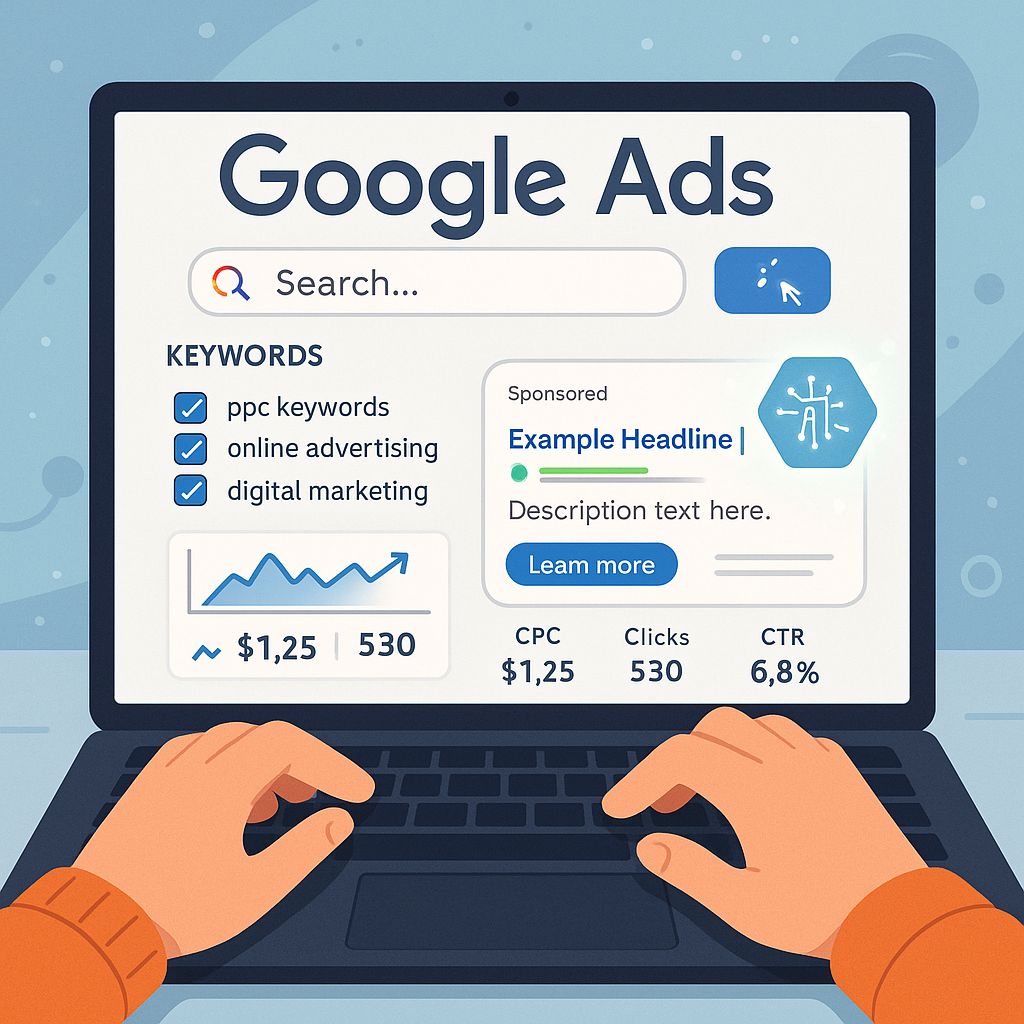Build Google Search Ads That Actually Convert
A Google Search Ad campaign done right can drive predictable conversions—even on a tight budget. This guide breaks down how to build a Google Search Ad Campaign from scratch using proven 2025 strategies. Most campaigns fail not because of budget—but because of bad structure and weak strategy. As a 22x certified Google Ads expert, I’ve built search campaigns for local businesses and eCommerce brands that drive real ROI. Here’s the exact step-by-step process to launch a high-converting Google Search ad campaign in 2025.
What You Will Learn Here:
Step 1 – Set a Clear Campaign Goal
Leads? Sales? Brand awareness? Pick one.
- Know your target CPA and customer LTV
- Align your Google Ads campaign strategy to outcomes, not just clicks
Step 2 – Structure Your Google Search Ad Campaign the Right Way
- Campaign Type: Search Network Only
- Campaign = One Theme (e.g., “Wedding Photographer Chicago”)
- Ad Groups = One Intent (e.g., “Affordable Wedding Photographer”)
- Keywords = Tightly grouped by intent and match type
Step 3 – Do Intent-Driven Keyword Research
Use these tools:
- Google Keyword Planner
- SEMrush / Ubersuggest
- Google Search Console
Target:
- High-intent keywords (“hire”, “emergency”, “near me”)
- Long-tail commercial intent keywords
- Create a list of negative keywords from Day 1
Step 4 – Write Compelling Ad Copy That Converts
Examples:
- “Rated #1 Emergency Plumber in Chicago”
- “Fixed Pricing | 24/7 Response”
- “Book Online in 60 Seconds”
Tips:
- Mirror user intent
- Use trust signals (local, certified, reviewed)
- Add urgency (limited-time offers, fast response)
Step 5 – Use Ad Extensions to Increase CTR
Don’t skip these:
- ✔ Sitelinks
- ✔ Callouts
- ✔ Call Extensions
- ✔ Structured Snippets
Pro Tip: Extensions improve Quality Score and lower CPC.
Step 6 – Send Traffic to a High-Converting Landing Page
Checklist:
- Mobile-optimized
- Fast load time (<2s)
- One clear CTA
- Includes trust elements (badges, reviews)
- Proper conversion tracking (Tag Manager or native tracking)
Step 7 – Choose the Right Budget & Bidding Strategy
Start with:
- Manual CPC + Enhanced CPC
- Shift to Max Conversions or Target CPA after 30–50 conversions
Budget Tip: Start with at least 10x target CPA as your daily budget.
Step 8 – Use Negative Keywords to Maximize ROI
Add these early:
- “Free”
- “Jobs”
- “PDF”
- “DIY”
- “YouTube”
Update your Search Terms Report weekly. Build a master negative list to reuse.
Step 9 – Optimize Like a Pro
Within Week 1:
- Monitor CTR, CPC, conversions
- Pause underperformers
- Test new ad versions
- Adjust for device, location, and time
Step 10 – Scale What Works
- Increase budget on top ad groups
- Duplicate winners for other geos
- Add new keyword variations
- Introduce remarketing or LSAs
Common Mistakes to Avoid When Scaling:
- Scaling all ad groups without filtering for ROI
- Increasing budgets too fast (stick to <20% weekly growth)
- Expanding keywords without refining negatives
- Neglecting landing page optimization while scaling
Tools That Make Campaign Management Easier
- Google Ads Editor – for bulk changes
- Google Analytics – for post-click insights
- Tag Manager – for fast implementation
- Looker Studio – for dashboards
- Google Ads Experiments – for controlled testing

Final Takeaway: Launch Right, Scale Smart
Great search campaigns aren’t built with luck—they’re built with structure, strategy, and smart optimization. Follow this checklist, or book a pro to build it for you.
📞 Book a Free 15-Minute Strategy Call
🔍 Request a Campaign Audit
📅 uradspartner.com/contact
About the Author
UR Ads Partner
🕊 22x Google Ads Certified
💼 Small Business Growth Strategist
🌍 Specialist in High-Converting Search & Local Ads
📍 Serving Clients Globally | Based in [Your City]
🌐Some Helpful External Links:
FAQ Section for Semantic SEO
What is the best bidding strategy for a Google Search Ad Campaign?
Start with Manual CPC and Enhanced CPC. Once you’ve collected 30–50 conversions, switch to Target CPA or Max Conversions for better scaling.
How do I make my Google Search Ad Campaign more effective?
Use tightly themed ad groups, include high-intent keywords, add negative keywords, write compelling ad copy, and send traffic to a conversion-optimized landing page.
